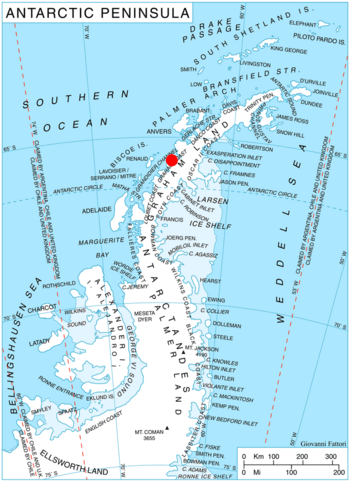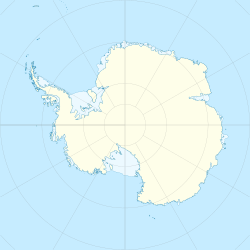Baurene Island facts for kids

Location of Magnier Peninsula on Graham Coast, Antarctic Peninsula
|
|
|
Location in Antarctica
|
|
| Geography | |
|---|---|
| Location | Antarctica |
| Coordinates | 65°42′38″S 64°25′00″W / 65.71056°S 64.41667°W |
| Administration | |
| Administered under the Antarctic Treaty System | |
| Demographics | |
| Population | Uninhabited |
Baurene Island is a small, ice-covered island located in the cold, icy lands of Antarctica. It's part of a group of three islands called the Correo Islands, found in Bigo Bay along the Graham Coast. This area is part of Graham Land, which is a big peninsula sticking out from Antarctica. Baurene Island is special because it only appeared recently, in the second half of the 1900s. It used to be covered by a thick ice cap from the nearby Magnier Peninsula, but as the ice melted, the island became visible.
The island is about 1.24 kilometers (less than a mile) long and 350 meters wide. It's named after a place called Baurene in Northwestern Bulgaria.
Where is Baurene Island Located?
Baurene Island is found in a very remote part of the world: Antarctica. Specifically, it's at 65°42′38″S 64°25′00″W / 65.71056°S 64.41667°W. It's the middle island in the Correo group. You can find it about 500 meters northwest of Komuniga Island. It's also about 450 meters southeast of another island called Lizard Island. British explorers mapped this area in 1971.
How Did Baurene Island Form?
Baurene Island wasn't always a separate island. For a long time, it was hidden under a huge sheet of ice. This ice was part of the ice cap covering the Magnier Peninsula. During the second half of the 20th century (from the 1950s onwards), the ice in this region started to melt and retreat. As the ice pulled back, Baurene Island slowly emerged. This made it a distinct piece of land, separate from the peninsula.
Why is it Called Baurene Island?
Many places in Antarctica are named after different locations around the world. Baurene Island got its name from a settlement called Baurene. This town is located in Northwestern Bulgaria. Naming places in Antarctica often honors different countries and their contributions to exploring the continent.


